-
Site Explorer
- Majestic
- Summary
- Ref Domains
- Backlinks
 New
New Lost
Lost- Context
- Anchor Text
- Pages
- Topics
- Link Graph
- Related Sites
- Advanced Tools
- Author ExplorerBeta
- Summary
- Similar Profiles
- Profile Backlinks
- Attributions
- Compare
-
Link Tools
- My Majestic
- Recent Activity
- Reports
- Campaigns
- Verified Domains
- OpenApps
- API Keys
- Keywords
- Keyword Generator
- Keyword Checker
- Search Explorer
- Link Tools
- Bulk Backlinks
- Neighbourhood Checker
- Submit URLs
- Experimental
- Index Merger
- Link Profile Fight
- Mutual Links
- Solo Links
- PDF Report
- Typo Domain
- Free SEO Tools
- Support
How to Check Your Backlinks
Backlink profile analysis is part of your ongoing activities as an SEO: you need to check your backlinks regularly.
How many backlinks does my website have?
This is one of the first questions you have probably asked about your website. It's the kind of question you ask when a new link building activity is under-way. Technically speaking, it's not the most relevant question an SEO should ask. We know quality is not quantity.
If you recall, in our previous article on how to evaluate a backlink, we suggested to check backlinks and review specific backlink profiles. In particular, we suggested to check backlinks in profiles where Trust Flow and Citation flow ratios are well below the 0.5 threshold. As a general rule of thumb, backlink profiles with many low-quality links may appear "spammy" at first sight.
We know that a single number is not going to give us much information to monitor our backlinks, but it is a starting point - here are a few considerations:
- A large number of organic low-quality links in backlink profiles could mean a broad readership. Low Trust Flow doesn't automatically imply low quality by definition. They could be quality backlinks from tiny, less-known sites with few (if any) backlinks.
- A small number of backlinks with high Trust Flow, signal the presence of quality backlinks.
The web is an extremely dynamic environment
There are new websites going live and other ones shutting down: the numbers are constantly shifting. At best, we can have a partial snapshot of what the situation was yesterday. We don't know what it's like today, and tomorrow is just as unpredictable. That's why it's a good idea to answer the question of how many backlinks does my website have?
What you will learn by reading this article
Here we tackle the question on how to monitor backlinks. We will use the Majestic platform tools.
We start reviewing the most relevant tools Majestic provides to check backlinks. The article then examines the data from backlink profiles. You will find a detailed explanation of the parameters used in backlink counts.
Finally we'll see the different reports in Majestic. Generating reports to check backlinks for massive sites can be difficult. Suppose you were to take a backlink inventory for a website with one million backlinks - where do you start?
We'll work our way through these challenges and ultimately answer the question: "How many backlinks do I have?"
Article Index
Majestic Campaigns

A first way to look at backlinks is via the Majestic campaigns.
What is a Campaign?
Majestic campaigns are a way to group and track a single or collection of domains or URLs over time. Every time Majestic updates the Fresh Index so will your campaign. Campaigns are grouped in a summary dashboard. The dashboard highlights important metrics and the number of backlinks in the Fresh Index. You'll find Campaigns on your account page. To help you set up your own campaigns Majestic have set up a default demo. You can see campaigns in action here and quickly understand how to work with them.
Campaign Setup
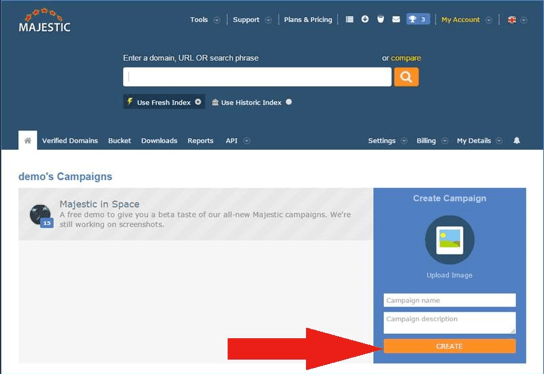
Campaign setup is easy and fast. Start counting backlinks by filling in the name and description.
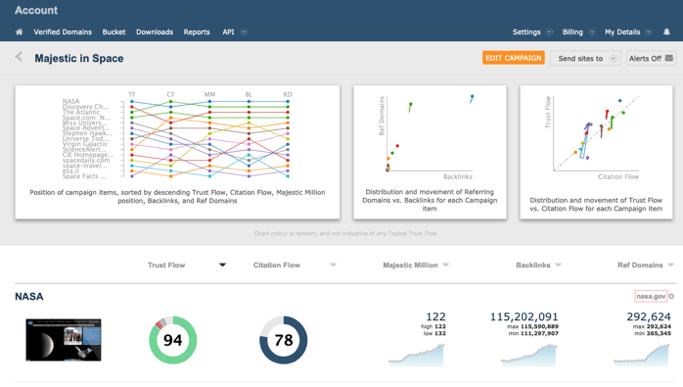
Once set up, there are three charts at the top of the page as you can see in the screenshot taken from the Demo campaign. The tables are clickable and lead to other areas of the platform, where you can obtain more information inside each vertical. Campaigns are particularly useful to check backlinks and track backlink counts of a profile.
When can this be helpful?
There are cases when a backlink count is important. For example, a sudden surge in the number of backlinks could be a strong signal that some of your content has gone viral. It could also mean spammers are targeting your website. In both cases, counting your backlinks will keep you informed on what's happening. You can automate the process by configuring email alerts for all your campaigns.
Site Explorer
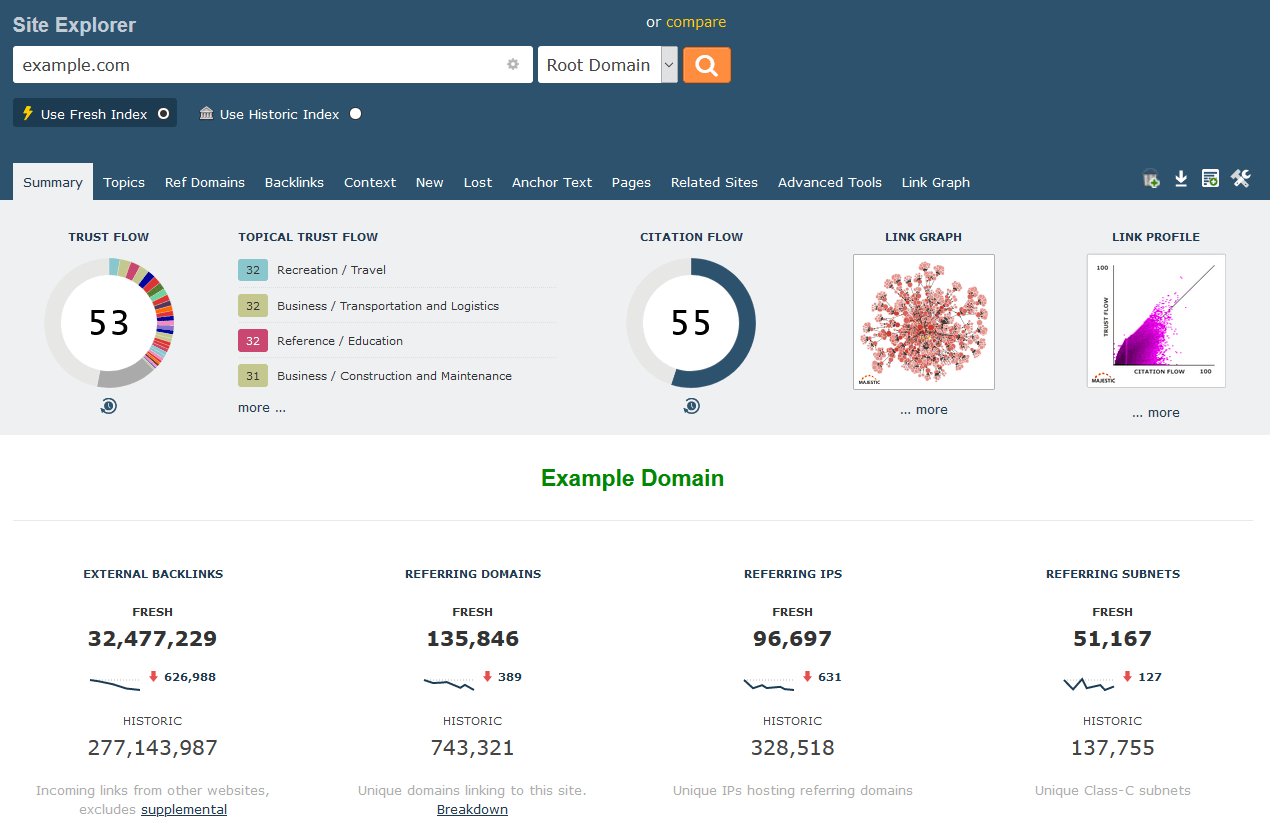
This is the tool for quick reference information. It allows you to access data to check backlinks. Majestic provides backlink counts at domain, subdomain, page or directory level. Backlink segmenting is an essential issue in audits of popular websites with an articulated backlink profile. When backlink counts move into the hundreds of thousands, segmenting is crucial. Backlink profile segmenting will avoid long wait time for data processing. Let's consider to ever so popular example.com. At the time of this writing, Majestic reports an astounding 263 million backlinks in the historic index. The fresh index reports just over 38 million. Downloads of these proportions are impossible for most users with a desktop computer. Segmenting the backlink profile, prior to download, is mandatory. We discuss backlink profile segmenting in detail towards the end of this article, when we describe reports and filtering backlink data.
Bulk Backlink Checker
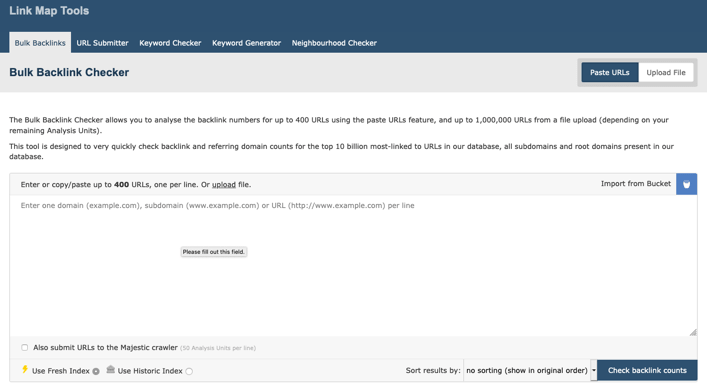
Another quick way to have backlink information is via the Bulk Backlink Checker Tool. With this tool, you can check backlink numbers for as many as 400 domains. The Bulk Backlink Checker is a handy tool for those of us in need of a quick so-called "Order of magnitude" number of backlinks. Link building strategies often require backlink counts for the most important competitors. This tool helps estimate how complex a link building effort may turn out to be, based on backlink counts.
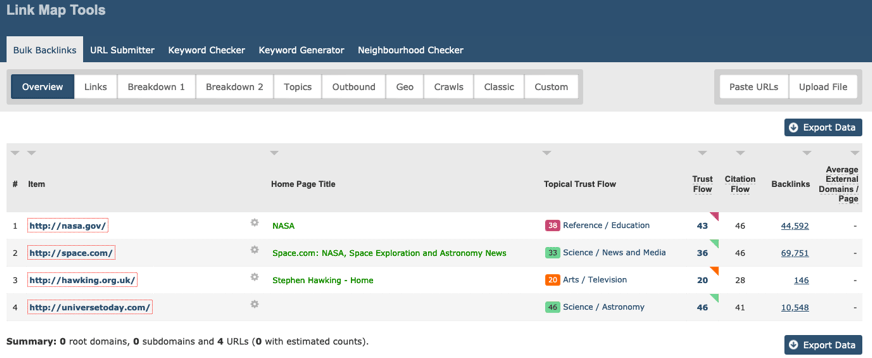
The Bulk Backlink Checker works similarly to the Majestic Site Explorer. It helps collect vital data to check backlinks. The export function allows CSV data exports for manipulation and ranking. Backlink counts and metrics produce data for an accurate analysis of your competitors' backlinks.
Data from Backlink Profiles
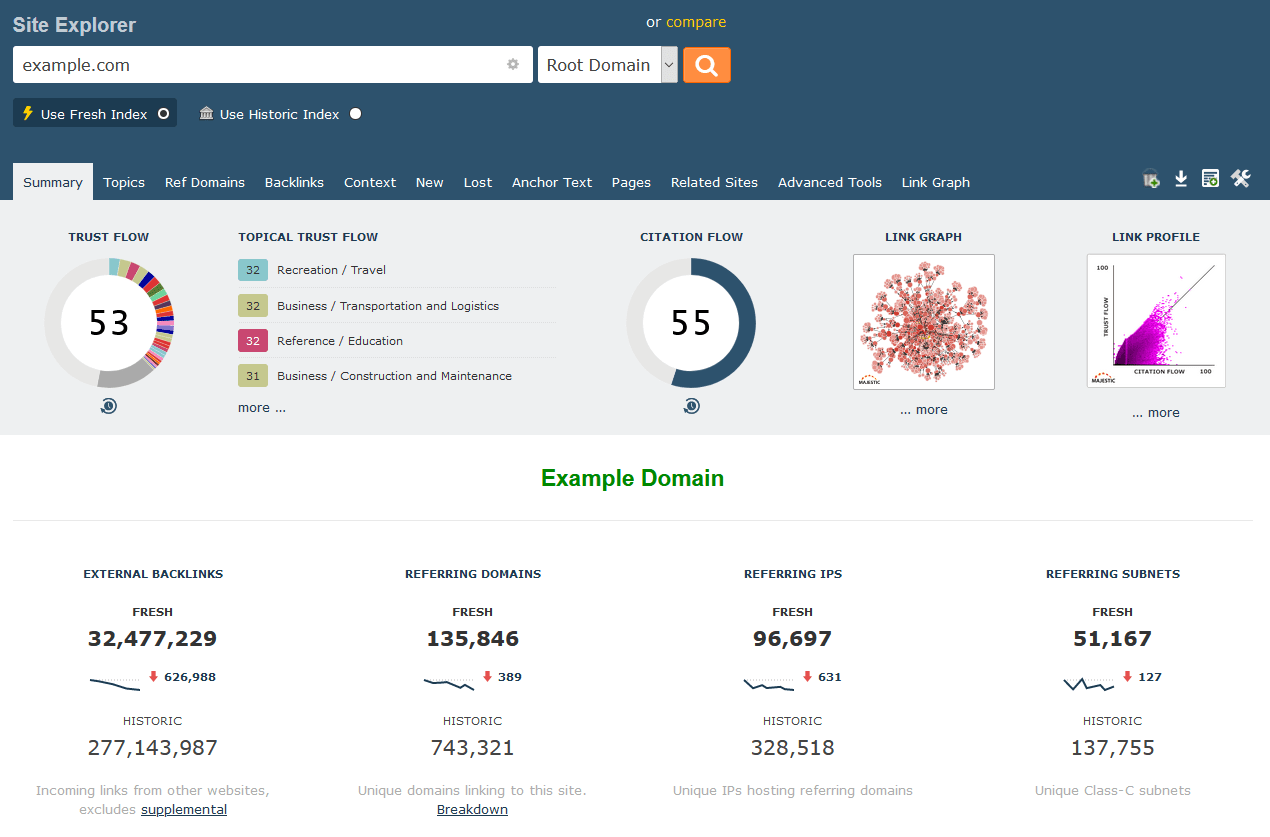
Now we examine the essential elements of a backlink profile in order to check backlinks. So far, we have defined a backlink profile without actually looking at one in detail. Now we're going to examine the tools to perform a backlink analysis. In the second part of this article on counting backlinks, we will move on to reports and filters which are essential to monitor a backlink profile.
Topics - Topical Trust Flow
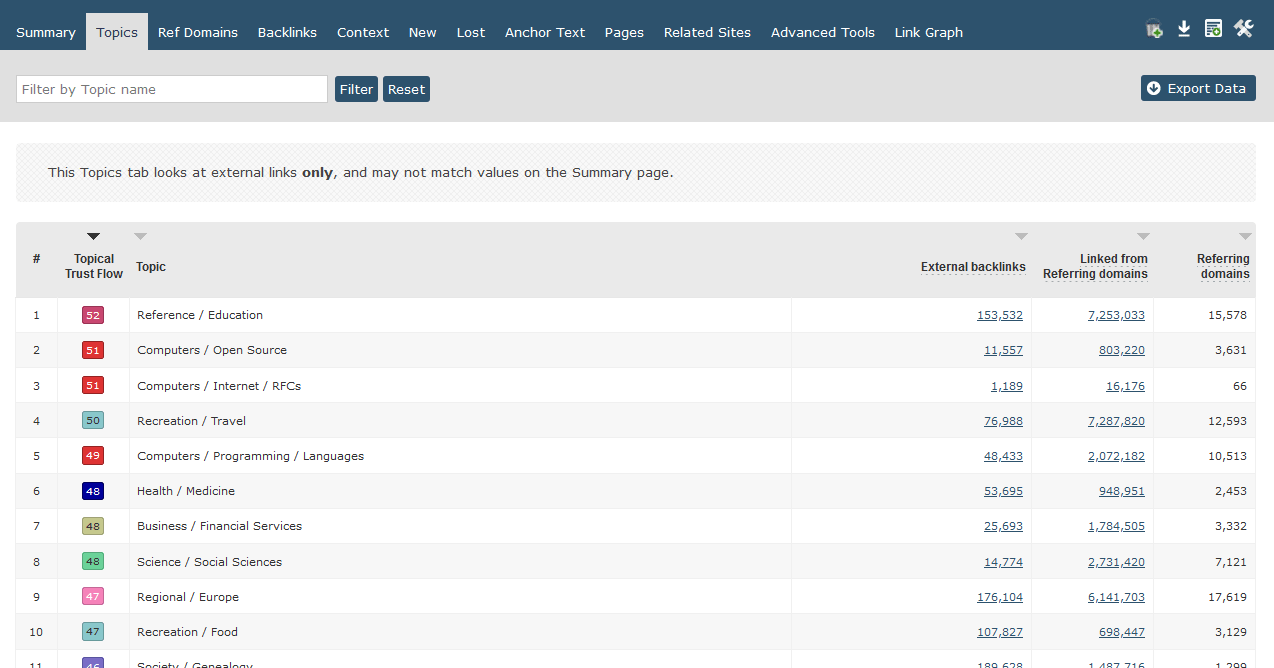
It's the first tab of a series of nine where you find all the backlink profile data. The Topical Trust Flow section presents data organised by topical relevance. Here you can identify how many backlinks are in a backlink profile for a specific topic. Majestic created a taxonomy consisting of more than 850 categories. From this section, you can download and check the top 100 links - the most important for each category.
Referring Domains
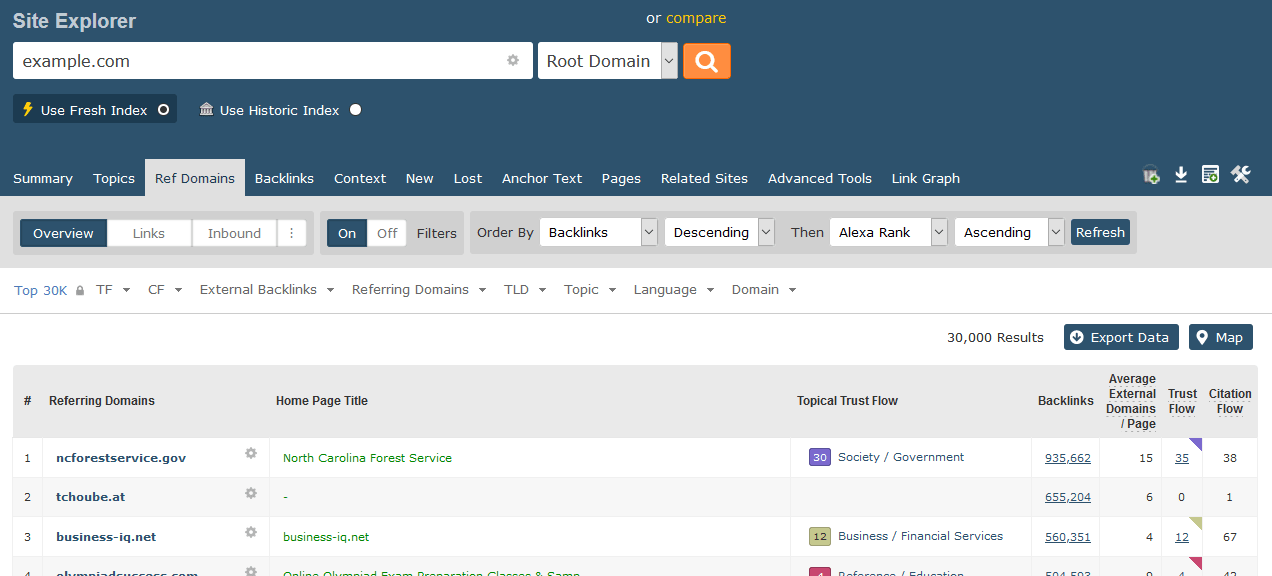
This section of Site Explorer reports backlink numbers at domain level. In other words you can check how many backlinks come from the source domain (the referring domain).
Backlinks
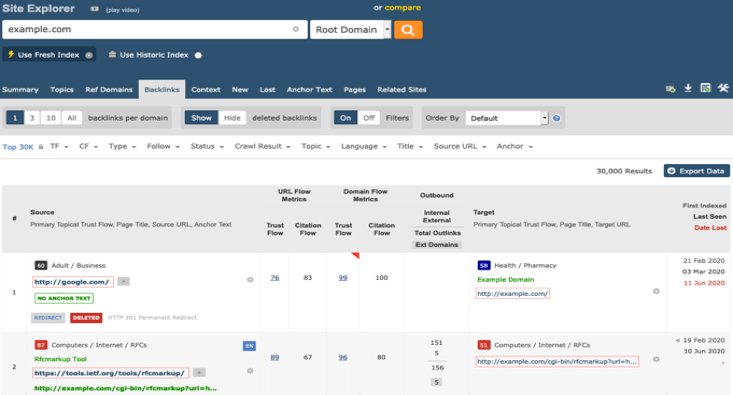
This tab provides a "shortlist" of backlinks. The backlinks tabs returns the top thirty thousand links. These links are immediately available for download. You'll notice how much information is available for each link.
New Backlinks
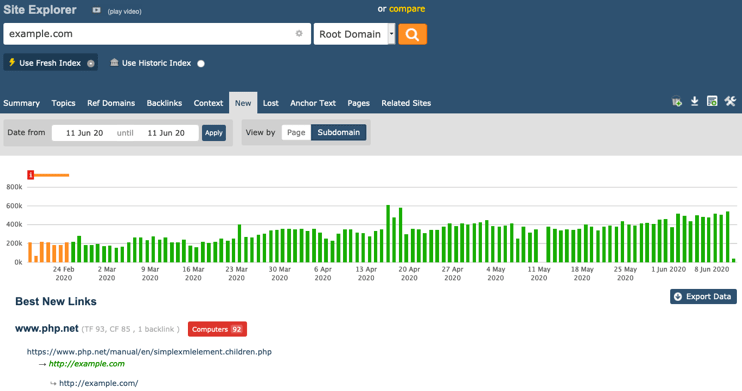
Here is the New Backlink count metric used by the majority of our users. The new backlinks tab offers a view of backlinks the site has recently acquired. When you check backlinks in this report, you may find some which already exist in your historic index. The Fresh Index has a short memory and is interested only in the most recent links. The first week of new links in a memory cycle can often contain historic links, recently crawled and rediscovered.
Lost or Deleted Backlinks
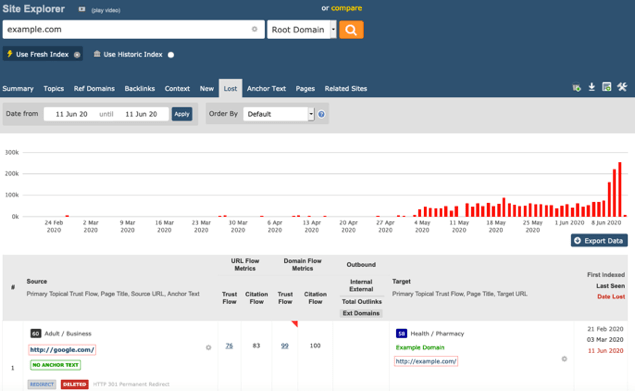
This is a report on the number of deleted backlinks: in other words, this report provides data to check backlinks reported LOST over the past 90 days. This information is based on the data coming from the Fresh Index. As per Link Context, Anchor text Pages and Related Sites are not relevant in this article. Therefore we will not cover them. Right now, our primary focus is on backlink counts and how many backlinks we have.
Reports
There is an incredible amount of data to check backlinks you can harvest directly online in Majestic. Point to a metric, click and download for further elaboration and reporting. It's as simple as that. But sometimes it isn't enough. You need more data for detailed analyses to check backlinks pointing to a website. That's when you need a report.
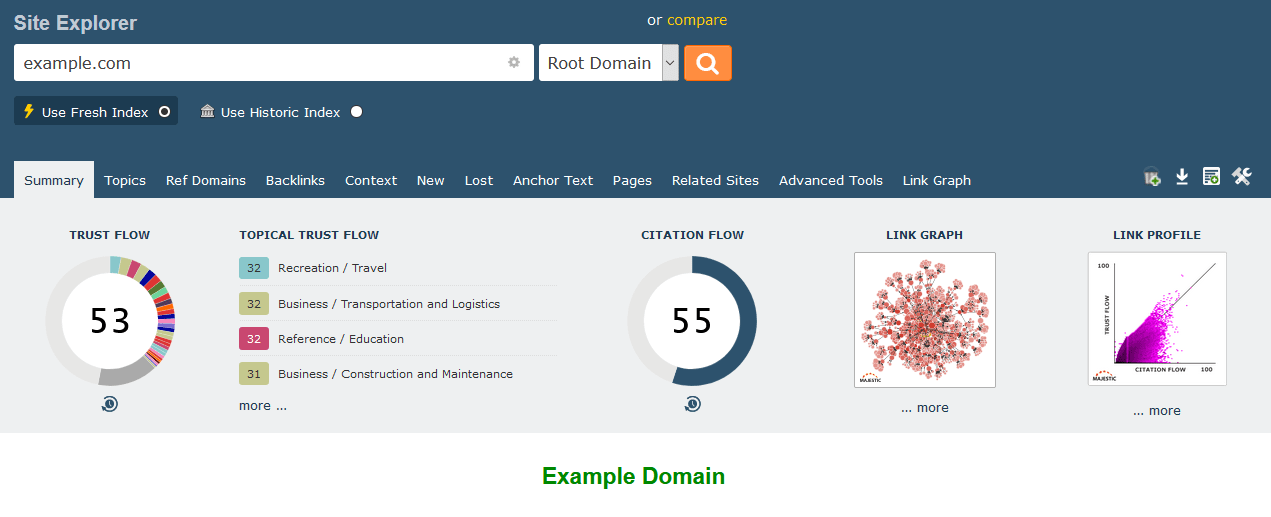
Reports go deep. They provide much more information to check backlinks: reports deliver more data on backlinks and more metrics than Site Explorer. You can create reports from just about any page. Majestic have two main report types Standard Reports and Advanced Reports. Standard reports provide in-depth detailed data for the most important links to a website. Advance reports provide all the backlink data for Root Domain, Subdomain or URLs. There is a third kind of report which is not focused on backlink counts and metrics. It's the Tracking report. Tracking reports provide link quality characteristics over time. You can create FREE reports for any domain you control. But first you need to verify your domains.
Reports Configuration
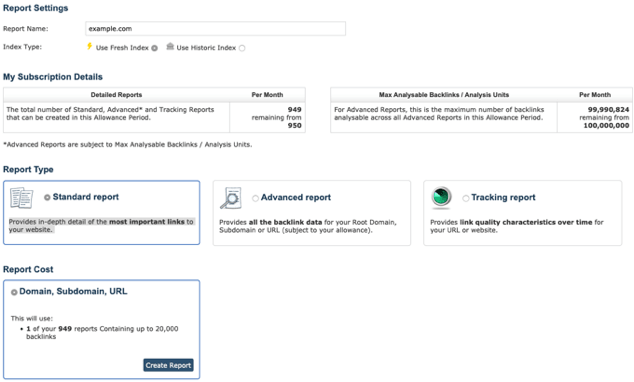
The download function provides files in CSV format. Convert to the format of your preference and start processing the data! Reports provide all the information we have reviewed so far in this lesson. Configure your report, then click on Create Report. Majestic generates the report in real-time.
Check Backlinks with Filters
So we now know how to create a report to download all the data you need to count and check backlinks. But wait, we have also mentioned there could be problems for large datasets. The problems we face to monitor backlinks are not only technical but also financial. Downloading data is expensive, so you'll want to download and save only the data you need. This is where filters come in handy. They avoid data overload and useless processing. In this last part of this article, we show you how to use filters.
Filtering data before creating a report
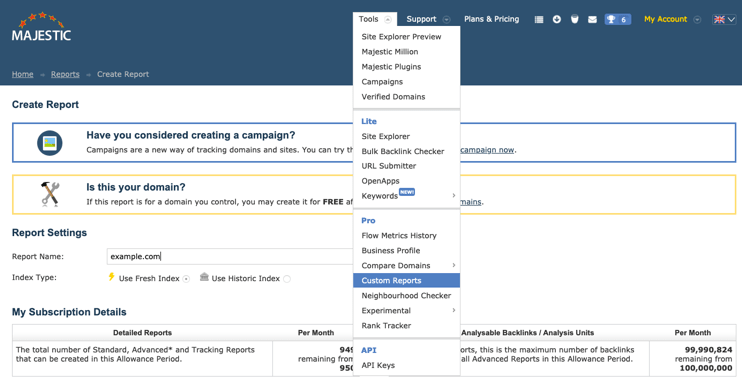
All your reports are available in the custom reports section of Majestic. Click on the Tools menu, then custom reports. Majestic will open your personalised reports page.
Reports Page
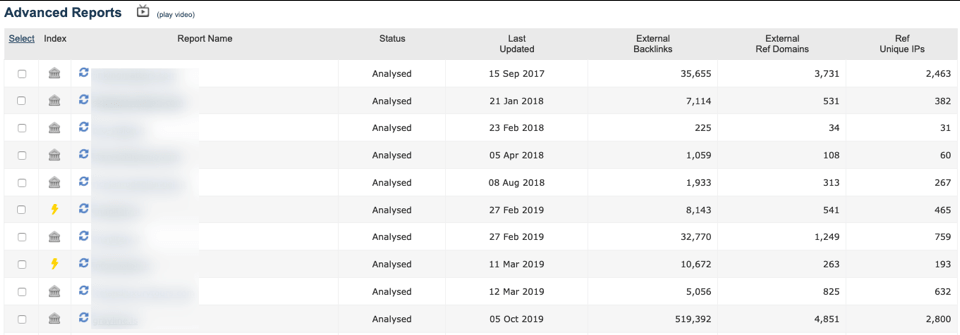
The house and the bolt icons indicate the historical or the fresh index. To update an existing report, click on the circular symbol. The report update time will depend on the number of backlinks. If it's a big report with a considerable amount of backlink data, be patient. Majestic will advise you when the data is available for download. Click and open the report.
Download Options Page
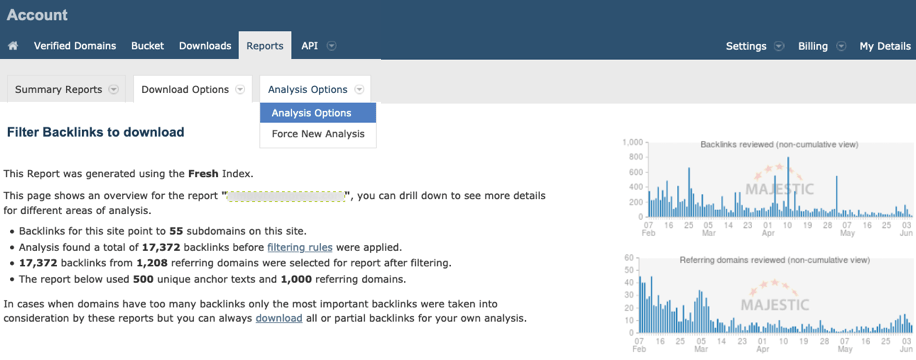
Now, this is where you can opt to download everything OR filter your data and download only a segment to focus on the most relevant backlinks you need to check. Remember, the more you download, the more resources you consume. From the Analysis Options sub-menu, choose Analysis Options.
Filter Options and Configurations
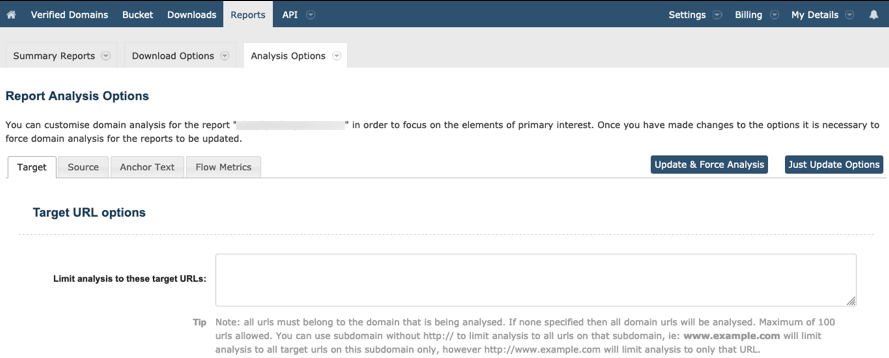
Now filter your data. Depending on the backlink count, this operation will require more or less time and effort. It depends on your experience and computer skills. We advise you to take your time and learn how to configure the filters, so you get the right amount of data. Chances are, you won't get filtering right the first time around: it takes some experience!
Start with a small backlink profile and download a minimal subset of data. Once you master all filtering options, move on to bigger data sets. You can limit your backlink data to single pages on your website (The target tab). Similar Filters also apply to Source URLs. For example, you might wish to check backlinks coming exclusively from specific geographical regions. With filters you can also check backlinks by date range. You can also analyse flagged backlinks (images, nofollow, deleted, AltText, etc.). Filtering can also be by anchor text and by enforcing anchor text filtering rules. I fact, you can filter backlinks from a dataset based on anchor text that matches a text pattern. And finally, you can filter backlinks using Flow Metric.
Summary: What you have learned in this Article
That was the last topic for this article, based on a general question amongst junior webmasters: How many backlinks does my website have? In this lesson, you have learned how to check backlinks and perform backlink counts. We have presented basic information so you understand why it is important to monitor your backlink profile. Backlink counts can be a starting point in defining your link building strategy. There are several options you can use to slice big datasets and check backlinks.
Could we improve this page for you? Please tell us